Kira Coley
-
- Extreme Sampling: Hadal Trenches Marine Technology, Sep 2015 #34
Deep-sea trenches represent one of the most extreme marine environments in the world. Although a subject of fascination for many scientists and ocean explorers, until relatively recently, they remain virtually unexplored due to the technical challenges in operating instruments and collecting samples at these extreme depths. Recent advances in underwater vehicles, image capturing and sampling technologies are increasing the opportunities for researchers to observe and uncover the mysteries of the deep. A team of international deep-sea scientists and engineers have embarked on a mission to build novel robots to explore and retrieve intact samples from the deepest parts of the ocean in a bid to discover how life is sustained thousands of metres below the ocean surface.
It was only in the last 50 years that advancements in technology have highlighted the importance of deep-sea environments in the carbon cycle. Deep-sea sediments represent an important compartment of this process - as organic matter settles onto the seafloor, it is either mineralized or buried into the sediment. One of the major challenges obstructing deep-sea research is inability to collect the samples required to understand biological processes at these extreme depths. Organisms that survive extraction from their natural environment do not necessarily considered important, while others are inevitably affected and typically killed due to changes in pressure.
While exploration of these zones has presented a challenge to scientists for decades, it is considered necessary to investigate the unexplored trenches and their specialised microbial communities to understand how organisms function at extreme pressures and what role they play in the global carbon cycle.
The ‘Hades‘ project – Benthic diagenesis and microbiology of hadal trenches (ERC Advanced Grant), aims to provide the first detailed, combined analysis of benthic diagenesis and microbial ecology and diversity of some of the deepest oceanic trenches on Earth.
An international team of researchers, led by Prof Ronnie N Glud from University of Southern Denmark (DK), and including scientists from Max Planck Institute for Marine Micribiology (G), Scottish Association of Marine Sciences (UK) and the University of Copenhagen (DK), will take the innovative step of studying and sampling deep-sea organisms in their own environment (in-situ). To achieve this, the Hades project requires two purpose-built robots, a profiling lander and sediment sampler (which will have two different modes), to operate at depths of up to 11 kilometres in cold, corrosive conditions, withstanding pressures reaching 1100 bar. Various components for the new robots are being produced around the world before finally being assembled at University of Southern Denmark.
Prof Ronnie Glud explains, “We argue that deep trenches, some of the most remote, extreme, and scantily explored habitats on Earth, are hotspots of deposition and mineralization of organic material. With the development of innovative, autonomous in situ instrumentation to overcome large sampling artifacts from decompression, we will i) determine rates of benthic metabolism and the importance of the deep trenches for the marine carbon and nitrogen cycle, ii) explore the unique benthic microbial communities driving these processes, and iii) investigate the proposed great role of virus in regulating microbial performance in hadal sediments.“
Previous expeditions such as the Mariana Trench in 2010, have revealed surprisingly high levels of biological activity at nearly 11 kilometres deep. The Hades project now aims to investigate how life is sustained at these depths and how its activity affects the biogeochemical functioning of the oceans and the Earth.
In the Pacific Ocean, three trenches have been selected based on the different nutrient conditions in the overlying surface waters and different physical-oceanographic conditions, influencing the volume of organic matter at each site: the Atacama Trench off Chile (max depth 8068 metres), the Japan Trench, south and east of Japan (max depth 9,504 metres) and the Kermadec Trench north of New Zealand (max depth 10,047 metres).
Sampling the Hadal Trenches
Each robot will be built to perform a particular task - one robot will be designed to quantify the oxygen uptake by the sediments. A second will investigate alternative anaerobic (i.e. oxygen free) processes that may be used by sediment organisms to convert the organic material (e.g., nitrate or sulfate for respiration). The third robot will be designed to collect sediment samples to be brought to the surface. This instrument will ensure the sampled microorganisms are fixed in-situ and can be retrieved without being modified during sample retrieval.
The sediment O2 uptake, determined from concentration profiles, provides an excellent proxy for the turn-over of organic material in marine sediments. During a previous cruise, the team used a profiling lander consisting of an electronic cylinder housing, capable of carrying up to 11 micro-sensors (oxygen and resistivity). The electronic cylinder with the sensors was moved in steps of 100 - 250µm across the sediment-water interface into the seafloor, down to a depth of approximately 15 cm. After the vertical profile was finished, all sensors were moved back to the start position. The electronic cylinder was then moved horizontally and the vertical profiling started again. This procedure enables the measurement of >100 profiles along a 40-cm transect per deployment.
“We used a “Benthic Profiling Ultra-Lander System” to perform high-resolution oxygen concentration profiles down to a depth of 11,000m. The prototype has demonstrated proof of concept, but has also given us experience that needs to be implemented for a more reliable performance. This includes new designs of gearboxes, vertical and horizontal instrument sledges, pressure compensation units, as well as the integration of batteries, specially designed buoyancy and acoustic releasers.“ Said Glud.
The “Autonomous Sediment Sampler and Injection Ultra-Lander System” will be able to either collect sediment cores or to inject tracers and fixation fluids. The latter will be used to study process rates or to preserve active microbial cells directly at the seafloor. The instrument design will be based on the traditional dampened coring principle of multiple corers and an injection lander providing high quality samples that remain mechanically undisturbed and guaranties a safe recovery of the lander.
Dr. Frank Wenzhoefer, of Max Planck Institute for Marine Micribiology, Bremen (Germany) explains, “Four core liners will be driven into the sediment by individual motors. When the core liners are retrieved, core catchers seal the liners at the bottom. The new instrument is an essential “work-horse” that, cost efficiently, will provide sufficient, mechanically undisturbed hadal sediment samples. For in situ incubation or fixation of sediment samples, the core sampler will be additionally equipped with an injection module. This will enable injection of substrates or fixatives along a central vertical trace in each core. For incubations, the instrument will remain at the seafloor for a preprogrammed duration.“
Using labeled substrates the system will be used for in situ quantification of transformations of nitrogen, sulfur and organic substrates, while also enabling the in situ injection of fixatives for subsequent microbial investigations and quantification.
The Engineering Challenges
Such lander systems have been used to water depths of 6000m, however the technical challenges and the fact that only 2% of the seafloor is below 6000m have, so far, limited scientists abilities to work at such great depth.
The high hydrostatic pressure, the corrosive environment and the fully autonomous operation of the systems are design issues engineers must face when building these systems. Electronics will require storage in pressure housing with high-pressure resistance connectors. Additionally, connectors for microsensors must have a high electrical impedance. Moving parts, like vertical and horizontal sledge systems, will also have to work properly at this high pressure as well as requiring all electrical and mechanical components to work autonomously.
“The most difficult aspect is the high hydrostatic pressure at which all components have to work and the fully autonomous operation of the systems - a proper lander-software is needed to control the working steps during the deployment. Furthermore malfunction of the autonomous operation would only be recognized after the recovery of the system, thus after several days of deployment.“ Said Wenzhoefer, “However, such lander systems will help, among others like video and photo-landers, to explore one of the last unknown and challenging habitats on earth. These systems can be used for further studies of microbial ecology and biogeochemical processes at numerous deep sea locations.“
By comparing trenches from contrasting oceanic settings the project provides a unique analysis of Hadal biogeochemistry and a deeper understanding of the role of deep trenches in the oceans, as well as fundamental new insights to the composition and functioning of microbial communities at extreme pressure.
Wenzhoefer explains, “The project is a great opportunity to enhance our knowledge on deep sea ecology and to explore so far unknown habitats of our planet. It is fascinating to deploy autonomous instruments at the deepest spots on earth and it is always an exciting event waiting for robots to surface, checking if everything worked properly and downloading the data or analyzing the samples. Within the new projects I am looking forward to discuss, design and operate new in situ technologies with our team of scientists, engineers and technicians all aiming for new ways to explore our planet.”
(As published in the September 2015 edition of Marine Technology Reporter - http://www.marinetechnologynews.com/Magazine)
-
- Project Mars: The future of Autonomy Marine Technology, Oct 2015 #24
Innovation and technological advancement is central to propelling maritime industries into a new era of efficiency. While the idea of autonomy is now a welcome solution for several military and scientific applications, other sectors are yet to fully take the concept on-board. As autonomous systems are
-
- SUPR-REMUS: The Next Generation of Plankton Sampling Marine Technology, Oct 2015 #28
A vast number of marine animals live a sedentary existence or with limited mobility as adults. For these individuals, it is the dispersal of larvae that determines the settlement of future populations and the structure of ecological communities. Plankton research is hindered by observational difficulties
-
- Evolution of Ocean Exploration: Mapping the Seafloor with Geodesy Marine Technology, Mar 2016 #28
a huge milestone in understanding our planet. Acknowledgements Professor David Sandwell, Scripps Institution of Oceanography The Author Kira Coley graduated with a BSc. (Hons) Marine Biology degree from University of Portsmouth and has extensive experience as a Field Scientist in various locations
-
- Offshore Innovation in Motion Marine Technology, Apr 2016 #22
Last year, a record $376 billion was invested in the U.K.’s renewable energy sector. With the U.K. Governments 2020 renewable energy target approaching, the race is well underway to shape the future of the industry through innovative solutions which offer long-term promise in both power efficiency and
-
- Echo Voyager: New Frontiers in Unmanned Technology Marine Technology, May 2016 #22
Subsea technology has begun to change the way we explore, manage and defend the marine environment. Fleets of unmanned vehicles will create sensor networks above and below the ocean’s surface and the ever-involving capabilities of these systems promise a future of robotic workforces completing dozens of
-
- Halls of Higher Learning Marine Technology, Aug 2016 #46
, universities and colleges are inextricably linked. Picking just five to feature in our MTR100 was no easy feat, but our U.K.-based contributor Kira Coley, as always, gave it her best shot. Scripps Institution of Oceanography - UC San Diego Topic: Education & Outreach No. of employees: 2,238 Address:
-
- A United Front in Ocean Observation Marine Technology, Sep 2016 #32
As the world’s oceans become increasingly exposed to rapidly growing pressures, long-term data sets are fundamental for monitoring these processes and understanding the complex and vast oceanic environment. In July 2016, the European Marine Board (EMB), a partnership of major national marine and oceanographic
-
- Exploring Alien Oceans with AUVs Marine Technology, Oct 2016 #22
Shielded by a thick, brittle ice surface, a vast warm ocean hides beneath. Scientists consider Jupiter’s smallest moon, Europa, to be the most promising for alien life and have set in motion multiple concept ventures to design an autonomous underwater vehicle (AUV) which could successfully explore this
-
- Methane: The Arctic's Buried Treasure Marine Technology, Nov 2016 #34
In pursuit for the Arctic’s buried treasure: methane Trapped beneath permafrost and ocean sediments, the release of the world’s largest natural gas resource, methane, has become a hot topic for international research. As rising temperatures continue to warm the Arctic region, the vast frozen fields of
-
- Brexit: What’s in Store for the Subsea Sector? Marine Technology, Nov 2016 #28
The UK subsea industry has grown by 40% over the past three years and now holds almost half of the global market. The EU referendum has plunged the industry into uncertainty and the UK must now wait to see how June’s historic vote shapes the future of one of its fastest growing sectors. The interconnected
-
- All Hands on Deck: ROVs and AUVs Aid Search for Franklin Marine Technology, Jan 2017 #22
Marine and subsea unmanned vehicle technology is playing an increasingly greater role in underwater archaeology, including the search for the historic shipwreck Franklin. For centuries, the ever-changing sea ice of the Northwest Passage made the route through the Arctic Ocean unpredictable and, on
-
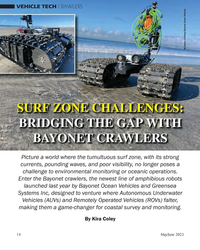 )
May 2023 - Marine Technology Reporter page: 14
)
May 2023 - Marine Technology Reporter page: 14Autonomous Underwater Vehicles (AUVs) and Remotely Operated Vehicles (ROVs) falter, making them a game-changer for coastal survey and monitoring. By Kira Coley 14 May/June 2023 MTR #4 (1-17).indd 14 5/31/2023 5:11:36 P
-
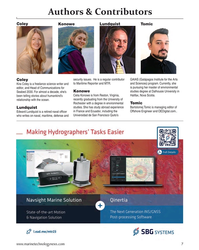 )
May 2023 - Marine Technology Reporter page: 7
)
May 2023 - Marine Technology Reporter page: 7issues. He is a regular contributor GAIAS (Galápagos Institute for the Arts Coley to Maritime Reporter and MTR. and Sciences) program. Currently, she Kira Coley is a freelance science writer and is pursuing her master of environmental editor, and Head of Communications for Konowe studies degree at Dalhousie
-
 )
May 2023 - Marine Technology Reporter page: 2
)
May 2023 - Marine Technology Reporter page: 2Vehicle Tech Crawlers in the Surf Zone The tumultuous surf zone presents many challenges. Bayonet Ocean crawlers can help bridge the gap. By Kira Coley 19 Family Affair Simon Partridge, 14 Covelya Group Simon Partridge helps to build on the solid foundation laid by his father in 1971. By
-
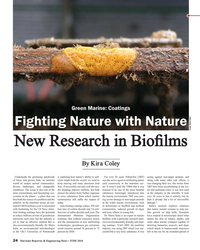 )
June 2018 - Maritime Reporter and Engineering News page: 24
)
June 2018 - Maritime Reporter and Engineering News page: 24Green Marine: Coatings Fighting Nature with Nature Credit: Maria Salta New Research in Bio? lmsNew Research in Bio? lms By Kira Coley Underneath the glistening patchwork is exploring how nature’s ability to self- For over 30 years Tributyltin (TBT) acting against non-target animals, and of blues and
-
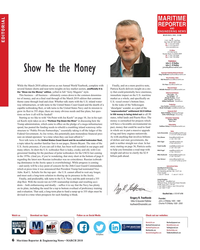 )
March 2018 - Maritime Reporter and Engineering News page: 6
)
March 2018 - Maritime Reporter and Engineering News page: 6.com , yelled in full “Jerry Maguire” style. ry that could potentially have enormous, the “Show me the Money” edition Editorial Contributors Kira Coley - UK This business – all business – ultimately comes down to the common denomina- immediate impact on the U.S. maritime Tom Mulligan - UK Claudio
-
 )
March 2018 - Marine Technology Reporter page: 35
)
March 2018 - Marine Technology Reporter page: 35By Kira Coley “What can we do differently?” The how we have adapted our products resonating question that over the last and services to today’s demands and decade has reshaped a historically market climate. While many of our slow-moving industry into the fast- competitors provide excellent instru- pace
-
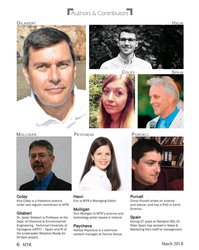 )
March 2018 - Marine Technology Reporter page: 6
)
March 2018 - Marine Technology Reporter page: 6Authors & Contributors G HILABERT AUN C SOLEY PAIN M P P ULLIGAN EYCHEVA URCELL Coley Haun Purcell Kira Coley is a freelance science Eric is MTR’s Managing Editor. Conor Purcell writes on science writer and regular contributor to MTR. and nature, and has a PhD in Earth Science. Mulligan Gilabert Tom
-
 )
March 2018 - Marine Technology Reporter page: 2
)
March 2018 - Marine Technology Reporter page: 2Dr. Javier Gilabert Instrumentation 34 Industry in Change From established leaders to dynamic start-ups, the pace of tech change is accelerating. By Kira Coley ADCP’s See Action 44 In OOI’s cabled observatory, sustained and interactive monitoring of NE Paci? c Ocean. By Dr. Peter Spain 50 The Digital
-
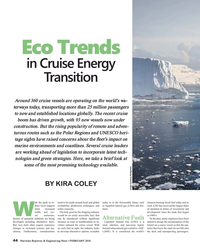 )
February 2018 - Maritime Reporter and Engineering News page: 44
)
February 2018 - Maritime Reporter and Engineering News page: 44legislation to incorporate latest tech- nologies and green strategies. Here, we take a brief look at some of the most promising technology available. BY KIRA COLEY Image Courtesy Hurtigruten ith the push to re- need to be made around local and global today or in the foreseeable future such cleanest-burning
-
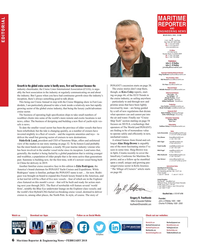 )
February 2018 - Maritime Reporter and Engineering News page: 6
)
February 2018 - Maritime Reporter and Engineering News page: 6don’t stop there, industry cheerleader, the Cruise Lines International Association (CLIA), is argu- Michelle Howard [email protected] though, as Kira Coley reports, start- ably the best association in the industry at regularly communicating on and about Editorial Contributors Kira Coley - UK ing on
-
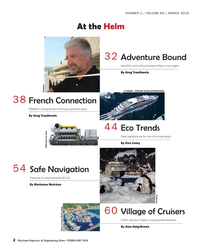 )
February 2018 - Maritime Reporter and Engineering News page: 2
)
February 2018 - Maritime Reporter and Engineering News page: 2is raising the bar in the luxury adventure sector. By Greg Trauthwein 44 Eco Trends Clean operations are the rule in the cruise sector. By Kira Coley MAN Diesel & Turbo 54 Safe Navigation Traversing icy waters demands 3D FLS. By Marianne Molchan The World 60 Village of Cruisers In Krilo Jesenice
-
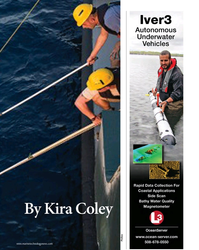 )
January 2018 - Marine Technology Reporter page: 31
)
January 2018 - Marine Technology Reporter page: 31By Kira Coley PicSea www.marinetechnologynews.com MTR #1 (18-33).indd 31 MTR #1 (18-33).indd 31 1/26/2018 12:31:03 PM1/26/2018 12:31:03 PM
-
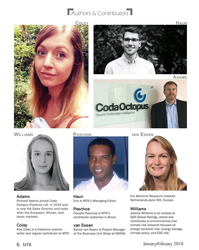 )
January 2018 - Marine Technology Reporter page: 6
)
January 2018 - Marine Technology Reporter page: 6Global Ratings, where she contributes to environmental and climate risk research focused on Coley van Essen energy transition risk, energy storage, Kira Coley is a freelance science Sanne van Essen is Project Manager climate policy, and ESG risk. writer and regular contributor to MTR. at the Business
-
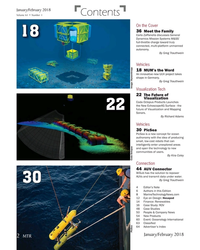 )
January 2018 - Marine Technology Reporter page: 2
)
January 2018 - Marine Technology Reporter page: 2the idea of producing small, low-cost robots that can intelligently enter unexplored areas and open the technology to new communities of users. By Kira Coley Connection 44 AUV Connector WiSub has the solution to repower AUVs and transmit data under water. By Greg Trauthwein 3030 4 Editor’s Note 6 Authors
-
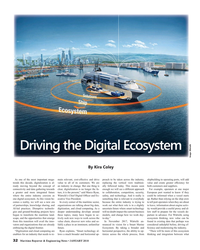 )
January 2018 - Maritime Reporter and Engineering News page: 32
)
January 2018 - Maritime Reporter and Engineering News page: 32Driving the Digital Ecosystem Image: Wärtsilä By Kira Coley As one of the most important mega- main relevant, cost-effective and drive proach to be taken across the industry, shipbuilding to operating ports, will add trends this decade, digitalization is al- value to all of its customers. We are replacing
-
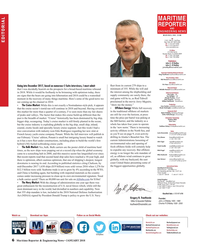 )
January 2018 - Maritime Reporter and Engineering News page: 6
)
January 2018 - Maritime Reporter and Engineering News page: 6.com the interest among the shipbuilding and in 2018. While it would be foolhardy to be brimming with optimism today, there Editorial Contributors Kira Coley - UK supply community are surely there, the are signs that the bears are going into hibernation and 2018 could be a watershed Tom Mulligan - UK Claudio
-
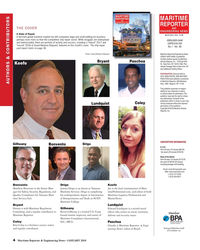 )
January 2018 - Maritime Reporter and Engineering News page: 4
)
January 2018 - Maritime Reporter and Engineering News page: 4Reporter. Guard marine inspector, and owner of defense and security issues. Maritime Compliance International, Coley LLC, (MCI). Paschoa Kira Coley is a freelance science writer Claudio is Maritime Reporter & Engi- Business Publications Audit and regular contributor. neering News’ editor in
-
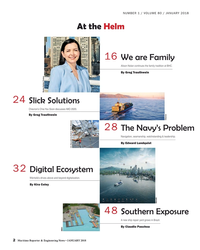 )
January 2018 - Maritime Reporter and Engineering News page: 2
)
January 2018 - Maritime Reporter and Engineering News page: 2& leadership. By Edward Lundquist U.S. Navy photo by Daniel A. Taylor/Released 32 Digital Ecosystem Wärtsilä’s drives above and beyond digitalization. By Kira Coley Wärtsilä 48 Southern Exposure A new ship repair yard grows in Brazil. By Claudio Paschoa BBDC 2 Maritime Reporter & Engineering News • JANUARY
-
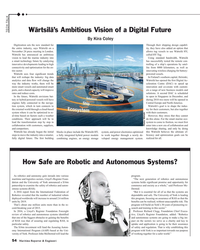 )
December 2017 - Maritime Reporter and Engineering News page: 54
)
December 2017 - Maritime Reporter and Engineering News page: 54Wärtsilä’s Ambitious Vision of a Digital Future TECH TALK By Kira Coley Digitization sets the new standard for Through their shipping design capabil- the entire industry, says Wärtsilä on a ity, they have also added an option that November 24 press meeting in London. allows tug vessels to use Wärtsilä
-
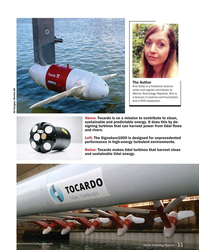 )
November 2017 - Marine Technology Reporter page: 35
)
November 2017 - Marine Technology Reporter page: 35The Author Kira Coley is a freelance science writer and regular contributor to Marine Technology Reporter. She is a lecturer in science communication and a PhD researcher. All Images: Nortek AS Above: Tocardo is on a mission to contribute to clean, sustainable and predictable energy. It does this by
-
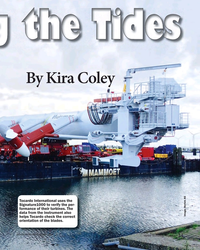 )
November 2017 - Marine Technology Reporter page: 31
)
November 2017 - Marine Technology Reporter page: 31By Kira Coley Tocardo International uses the Signature1000 to verify the per- formance of their turbines. The data from the instrument also Image: Nortek AS helps Tocardo check the correct orientation of the blades. www.marinetechnologynews.com Marine Technology Reporter 31 MTR #9 (18-33).indd 31
-
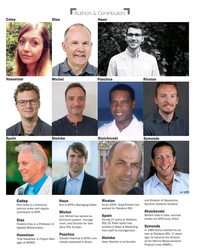 )
November 2017 - Marine Technology Reporter page: 6
)
November 2017 - Marine Technology Reporter page: 6DiasHaun Hasselaar Paschoa MichelRivalan Spain Stoichevski Steinke Symonds and Director of Operations, Coley Haun Rivalan Dynamic Systems Analysis. Kira Coley is a freelance Eric is MTR’s Managing Editor. Since 2005, Greg Rivalan has science writer and regular worked for Teledyne RDI. Stoichevski contributor
-
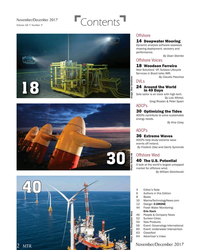 )
November 2017 - Marine Technology Reporter page: 2
)
November 2017 - Marine Technology Reporter page: 2track with high tech. By Loïc Michel, Greg Rivalan & Peter Spain ADCPs 30 Optimizing the Tides ADCPs contribute to solve sustainable energy needs. By Kira Coley ADCPs 36 Extreme Waves ADCPs help study extreme wave events off Ireland. By Frederic Diaz and Darrly Symonds Offshore Wind The U.S. Potential 40 3030
-
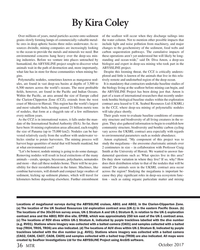 )
October 2017 - Marine Technology Reporter page: 36
)
October 2017 - Marine Technology Reporter page: 36By Kira Coley Over millions of years, metal particles accrete onto sediment of the sea
